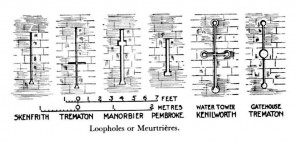A Few Odds and Ends
I like words and I am intrigued by the origin of words, or epistemology. Here a few words whose meanings are loosely associated with architecture:
Balk
To balk, to stop short , to pause before proceeding as though an obstacle were in the way. The word itself comes from the Old English, balca, or beam. In the days before locks, these beams were placed across doors to keep out enemies and intruders.
Cahoots
Cahoots were little cabins, or kajuetes, as they were called in medieval Germany. Often known to be occupied by bandits and robbers, these little cabins became the planning centers for attacks.
Eavesdropping
Eavesdropping goes back to the old country, when property owners could not build their houses right up to their property lines. Instead, they had to leave space for the eaves, and the drippings from the rain and weather. The “eavesdrip” was that space between the houses, roughly two feet wide, when a nosy neighbor could easily drop by to overhear this neighbor’s business.
Loophole
In castles of old, loopholes were a common architectural structure built into the walls themselves, as a form of security for times of war. These small openings, spaced every few feet apart, were designed both for observation as well as for firing small weapons. While the holes were small and narrow, if need be, they could serve as a means of escape should the castle be taken under attack.
Odds and Ends
The first official odds and ends were found in lumberyards, as they were, quite literally, leftover scraps of wood. Odds were pieces of board split irregularly by the sawmill that were less than even in shape. The ends were those end pieces trimmed from boards that were cut to specific lengths.
Threshold
Farmhouses of old had nothing but earth for floors, so for covering, leftover threshing from the fall harvest were often scattered on the floor to serve as insulation against the cold ground. To keep the threshings at the entrance from blowing out every time a door was opened, stone or wooden thresholds were invented to hold the loose trappings in place.
The above definitions are quoted from “I Didn’t Know That” by Karlen Evins, NY: Scribner, 2007.
-TJC
